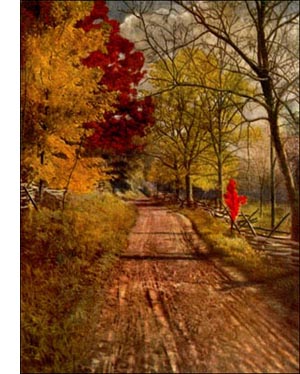White Spruce Tree
 White Spruce (Picea Canadensis, B. S. & P.)-Broadly pyramidal tree, 6o to I 5o feet high, with stout branches, smooth twigs and bad-smelling foliage. Bark greyish brown, breaking into scaly plates. Wood light, soft, yellow, brittle. Buds ovate, scaly. Leaves spread on upper side of twig, bluish, sharp, hoary when young, I to j inch long. Flowers both kinds cone-like, pale red, turning yellow. Fruit oblongcylindrical, stalked cones, blunt ; scales blunt or notched at broad apex, shiny, thin, falling soon after seeds ripen. Preferred habitat, rocky slopes, banks of rivers or lakes. Distribution, Labrador to Bering Strait ; south to Montana, northern Dakota, Michigan and Wisconsin, New York and New England. Uses : Lumber for building and interior finishing, and for paper pulp. Tree planted for ornament and shade. Variety caerulea most common in cultivation.
White Spruce (Picea Canadensis, B. S. & P.)-Broadly pyramidal tree, 6o to I 5o feet high, with stout branches, smooth twigs and bad-smelling foliage. Bark greyish brown, breaking into scaly plates. Wood light, soft, yellow, brittle. Buds ovate, scaly. Leaves spread on upper side of twig, bluish, sharp, hoary when young, I to j inch long. Flowers both kinds cone-like, pale red, turning yellow. Fruit oblongcylindrical, stalked cones, blunt ; scales blunt or notched at broad apex, shiny, thin, falling soon after seeds ripen. Preferred habitat, rocky slopes, banks of rivers or lakes. Distribution, Labrador to Bering Strait ; south to Montana, northern Dakota, Michigan and Wisconsin, New York and New England. Uses : Lumber for building and interior finishing, and for paper pulp. Tree planted for ornament and shade. Variety caerulea most common in cultivation.The pale bark and pea-green foliage of the white spruce enable one to account for its name without difficulty and to identify it in the woods. The whitish wood is not distinctly paler than that of the black spruce. The ill-smelling foliage and the smooth twigs better distinguish it, and the cones, which are twice as long as the black spruce's. They are shed almost as soon as they open, a tree habit that keeps the branches clean and thrifty in appearance.
White spruce is the pulp manufacturer's delight. He owns thousands of acres of it. As lumber the wood is used only in Alaska and Canada in lieu of better kinds. The inferiority of spruce lumber has saved it for the comparatively new enterprise of pulp manufacture.